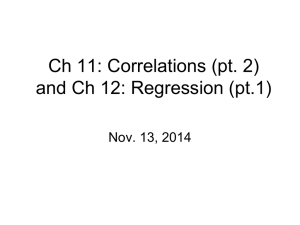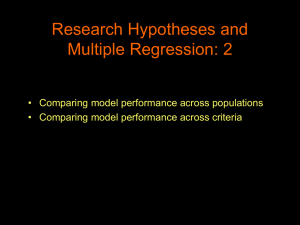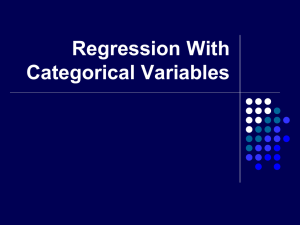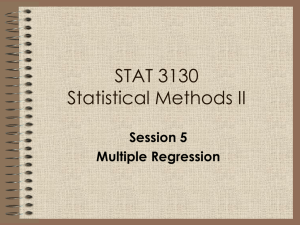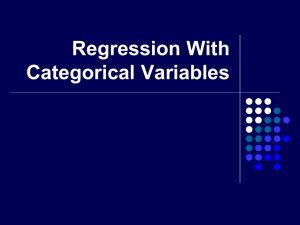06-ModeratorMediator
advertisement
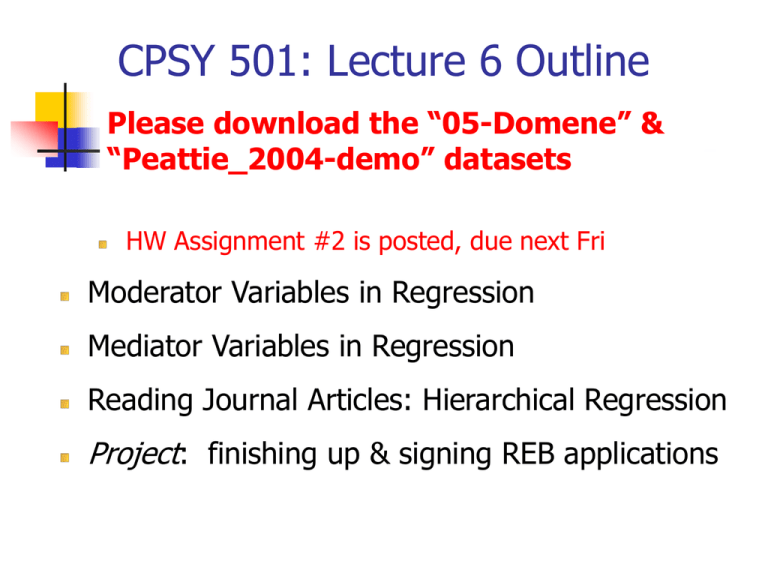
CPSY 501: Lecture 6 Outline Please download the “05-Domene” & “Peattie_2004-demo” datasets HW Assignment #2 is posted, due next Fri Moderator Variables in Regression Mediator Variables in Regression Reading Journal Articles: Hierarchical Regression Project: finishing up & signing REB applications Review: Regression Modelling Process Sequence for building and testing an OLS regression model: 1) Develop research question 2) data entry errors, univariate outliers and missing data 3) Explore variables (Outcome; Predictors) 4) Model Building: Mediation & Moderation 5) Model Testing: multivariate outliers or overly influential cases 6) Model Testing: multicollinearity, linearity, residuals 7) Run final model & interpret results Moderators in Regression Analysis Definition: When a variable interacts with a predictor to change the relationship between that predictor and the outcome variable: increase, decrease, or change direction (e.g., pos to neg). Assessing for moderation effects depends on the characteristics of your predictor and moderator: a) If both are categorical, either factorial ANOVA or regression (MR used for examining shared variance) b) If at least one is an interval/continuous variable, use multiple regression methods Testing for Moderators (Interactions) Process of testing for Moderators: a) Centre your (interval-level) predictor and moderator (recode: variable – mean score of the variable) b) Create your interaction term (Compute: centered predictor*centered moderator) c) Include the centered predictor, centered moderator in the regression equation in their normal order, but then add the interaction term in a subsequent block. d) In the new model, if the interaction term is significant, you have a moderator (interactions are common in research areas of counselling psych). Interpreting Moderators Significant interaction effects require us to rethink the “main effects” – the effects of each IV. The presence of a moderating effect indicates that the relationship between the predictor and the outcome variable is different for different kinds of people (kind being defined by the moderator). Theory is needed to determine how to interpret the interactions. Analytically, we need to graph the interaction to say what is going on. E.g., Birgitte Peattie’s thesis on marriage, stress, & sanctification. Moderation: Peattie (2004) Studying Buffering Effects of Marriage and Marital Satisfaction DV: Marital Satisfaction IV: Negative Life Events (NLE, stress) Mod: Joint Religious Activities (JRA) Buffering: high levels of a “buffer” weaken the impact of stress: => interaction Moderation: Online tool Paul Jose @Victoria University of Wellington Continuous moderator, Peattie (2004) B=-.071, mean=.8650, SD=4.11572 Moderator: JRA (centred): Y-axis (DV): Marital Satisfaction X-axis (IV): NLE (centred): http://www.victoria.ac.nz/psyc/staff/pauljose/files/modgraph/modgraph.php B=.056, mean=-.264386, SD=1.497915 Interaction term: B=.037 Constant: 5.757 ModGraph: Results Interpreting Interactions Slope of IV regression lines differ for various levels of the moderating variable Peattie study examples: hi levels of JRA show a weakening of the (negative) relationship of stress with marital satisfaction CPSY501 Lecture 06 Outline Moderator Variables in Regression Mediator Variables in Regression Reading Journal Articles – Hierarchical Regression Mediators in Multiple Regression: IVMDV Definition: A variable that, when entered into the regression model, explains or accounts for the relationship between a predictor and an outcome variable, so that the original relationship disappears or is attenuated (partial mediation). For a variable to qualify as a potential mediator, it must be “located” between the predictor and the outcome: according to theory, the predictor must “precede” the mediator in some clear manner. Testing for Mediators: IVMDV Process of testing for Mediators: a) All three variables must be significantly correlated, and the predictor must be significant in regression model b) Run a simple regression with just (a) the predictor, and (b) the mediator as the outcome variable. Is the predictor significant in the new model? c) In the original regression model, enter the predictor and mediator in the same block as the predictor variable (force enter): If the predictor is no longer significant, then there is a mediation effect. (If there are other predictors in the model, they should be retained in the model, in the appropriate blocks). Jose’s site for mediation http://www.victoria.ac.nz/psyc/staff/pauljose/files/medgraph/medgraph.php Strobel test: one strategy for checking partial mediation (weaknesses include power issues) http://people.ku.edu/~preacher/sobel/sobel.htm Interpreting Mediators Conclude that what appeared to be a real relationship between the predictor and outcome is actually an indirect relationship, and due to the mediator variable. Report (a) the relationships (βs & effect sizes) between the predictor and the outcome variable before, and after the mediator is entered into the model, and (b) the relationships between the mediator and predictor, and mediator and outcome variable (in the final model). [see Jose’s example] Further Reading - Articles See articles/ directory under today’s lecture: http://cpsy501.seanho.com/lectures/06 CPSY501 Lecture 06 Outline Moderator Variables in Regression Mediator Variables in Regression Reading Journal Articles – Hierarchical Regression Reading a Journal Article Multiple Regression: Missirlian, T. M., Toukmanian, S. G., Warwar, S. H., & Greenberg, L. S. (2005). Emotional Arousal, Client Perceptual Processing, and the Working Alliance in Experiential Psychotherapy for Depression. Journal of Consulting and Clinical Psychology, 73(5), 861-871. Overview: Emotional Arousal, Client Perceptual Processing, and the Working Alliance in Experiential Psychotherapy for Depression Research Question: “…client emotional arousal, perceptual processing, and the working alliance, together, would be a better predictor of therapy outcome than any one of these variables alone” (Missirilian, Toukmanian, Warwar, & Greenberg, 2005, p. 862) Participants: 32 of 500 individuals recurited met criteria for inclusion - screened to ensure mild to moderate levels of depression (no comorbid dx, no Axis II dx, no medications, not receiving treatment elsewhere) Method: Participants completed pre-treatment measures of depression (BDI); randomly assigned to 1 of 11 possible therapists to complete between 14 and 20 manualized sessions; 4 outcome measures were collected at 3 phases (early, middle, late) in the therapeutic process. Overview: Emotional Arousal, Client Perceptual Processing, and the Working Alliance in Experiential Psychotherapy for Depression Three Predictor Variables (i.e., therapeutic processes) Emotional Arousal: Two independent and blind raters rated the intensity of the emotional arousal clients reached in early, mid and late sessions using the Client Emotional Arousal Scale-III (they had a video tape of the session, as well as a transcript). An ‘average’ emotional arousal score was determined for each client across each session viewed. Perceptual Processes: Two other independent judges watched the same portions of the therapy process, rating the client’s level of perceptual processing using the Levels of Client Perceptual Processing (from ‘recognition’ at one end to ‘integration’ at other). Working Alliance: Clients completed at the Working Alliance Inventory at the end of each session. Overview: Emotional Arousal, Client Perceptual Processing, and the Working Alliance in Experiential Psychotherapy for Depression Four Outcome Variables: (i.e., Therapeutic Outcome) Depression: Beck Depression Inventory (BDI) Self-esteem: Rosenberg Self-Esteem Scale (SES) Stress due to Interpersonal Sources: Inventory of Interpersonal Problems (IIP) Psychopathology: Global Symptom Index (GSI) of the Symptom Checklist-90 (SCL-90) Method? Think back to the Research Question… “…client emotional arousal, perceptual processing, and the working alliance, together, would be a better predictor of therapy outcome than any one of these variables alone” What kind of a design are we working with? Longitudinal: Correlations between variables observed over time Procedure: Manualized therapy for clients with depression Measures: Coding of transcripts of therapy sessions (arousal, perceptions) & some self-report measures (BDI, WAI) Used a series of hierarchical regression analyses to test the predictive ability of the three therapeutic process measures in relation to the four outcome measures. Correlation matrix: Observing trends in the data *NO perfect multicollinearity: no perfect linear relationship b/w 2 or more predictors *Linearity: Assume the relationship we’re modelling is a linear one Results ‘Arousal’ adds only marginal Unique improvement over Perceptual Processes At mid-treatment, Emotional Arousal + Perceptual Processes significantly increased outcome prediction for Depression Results LCPP only adds ‘marginally’ unique improvements over WAI Adding the Working Alliance to the model containing Perceptual Processes Improved prediction of depressive symptoms during late-therapy (explaining 34% of the variance) Note: The small sample size (N = 31) does give these analyses limited power. Also: Experiment-wise (Family Wise) error rates are increased by the process of analyzing data using a model where later tests are built on findings of preceding statistical tests So: be careful not to dismiss results due only to ‘marginal significance’… Remember to pay attention to effect size too! Study limitations…suggestions? Homogenous sample (mild to moderate depression only) doesn’t mirror the reality of the clinical world. Self-report inventories for outcome measures (influenced by ‘demand characteristics’).



